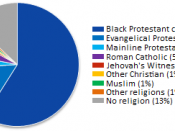The difficulties of becoming American
America has been and still is for many immigrants the country of equal opportunity, the country, where you find a better life, and one can have the freedom of individuality. The high immigration rates and the growing number of second generation immigrant children have caused concerns for the American society. One of these concerns is the fear of loosing the core American Culture, and another major concern is how second generation immigrant children identify themselves.
Mary C. Waters, describes in her book Black Identities: West Indian Immigrant Dreams and American Realities, how the children of Caribbean immigrants identify themselves. The process of self identification creates great conflicts between the immigrant parents and the children and the society they have to live in. The children have to make a choice between loyalty to the parents that hold on to the customs of their country of origin, or to adapt to the expectations of the society they encounter in their community.
As Natasha Warikoo, points out in Cosmopolitan Ethnicity: Second Gerneration Indo-Caribbean identies, race and ethnicity are socially constructed categories. Ethnicity is based on claims of shared history, symbols, and self asserted through cultural background, and race is usually assigned by others based on physical appearance for example skin color( Warikoo 62). Both, Warikoo and Waters research concentrates on second generation teenagers whose parents identify as West-Indians. Waters finds three modes of identity for the children of black West Indian immigrants: African American identity that largely associates with living in poor or working-class African American neighborhoods and with oppositional identity; ethnic identity, largely associated with living in mostly white suburbs and involving a distancing from African Americans by emphasizing ethnic identity, and immigrant identity (Warikoo 363).
For children to identify themselves they usually look their parents,



Well written
Overall this easy is okay, and the conclusion could be stronger.
0 out of 0 people found this comment useful.